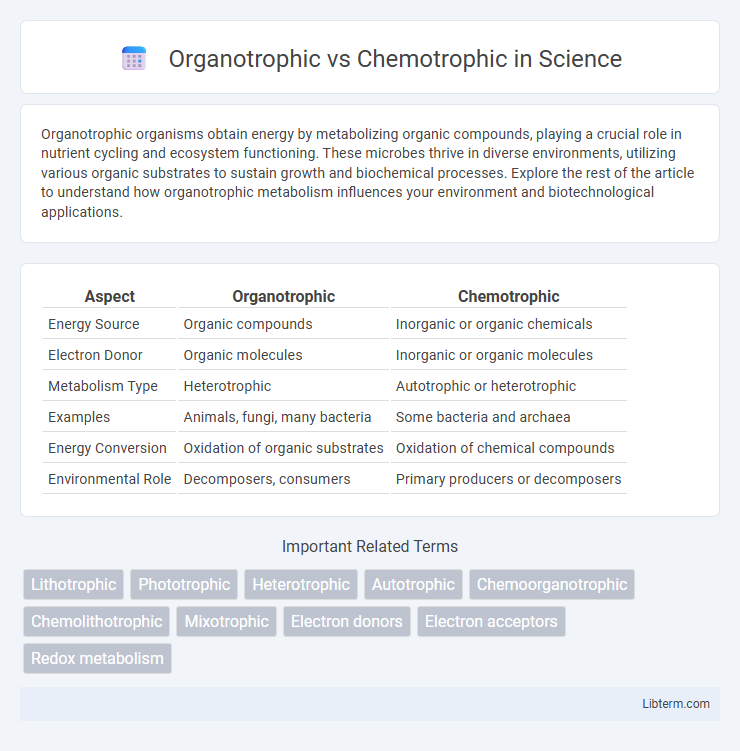Organotrophic organisms obtain energy by metabolizing organic compounds, playing a crucial role in nutrient cycling and ecosystem functioning. These microbes thrive in diverse environments, utilizing various organic substrates to sustain growth and biochemical processes. Explore the rest of the article to understand how organotrophic metabolism influences your environment and biotechnological applications.
Table of Comparison
| Aspect | Organotrophic | Chemotrophic |
|---|---|---|
| Energy Source | Organic compounds | Inorganic or organic chemicals |
| Electron Donor | Organic molecules | Inorganic or organic molecules |
| Metabolism Type | Heterotrophic | Autotrophic or heterotrophic |
| Examples | Animals, fungi, many bacteria | Some bacteria and archaea |
| Energy Conversion | Oxidation of organic substrates | Oxidation of chemical compounds |
| Environmental Role | Decomposers, consumers | Primary producers or decomposers |
Introduction to Energy Acquisition in Microorganisms
Organotrophic microorganisms acquire energy by oxidizing organic compounds such as carbohydrates, lipids, and proteins, which serve as both electron donors and carbon sources. Chemotrophic microorganisms obtain energy through the oxidation of inorganic or organic molecules, utilizing either electrons from chemical compounds in the environment rather than light. This fundamental distinction influences metabolic pathways, ecological roles, and adaptation strategies in diverse microbial communities.
Definition of Organotrophs
Organotrophs are organisms that obtain electrons from organic compounds during cellular respiration for energy production, distinguishing them from chemotrophs that can utilize both organic and inorganic electron donors. These organisms play a crucial role in ecosystems by decomposing organic matter and recycling nutrients. Understanding organotrophic metabolism is essential for studying microbial energy acquisition and biogeochemical cycles.
Definition of Chemotrophs
Chemotrophs are organisms that obtain energy by oxidizing chemical compounds, often inorganic substances like hydrogen sulfide or ammonia, rather than relying on light energy. Unlike organotrophs, which use organic molecules as electron donors, chemotrophs can utilize inorganic or organic chemicals to drive their metabolic processes. This energy acquisition method enables chemotrophs to thrive in environments lacking sunlight, such as deep-sea vents or soil ecosystems.
Key Differences Between Organotrophic and Chemotrophic Metabolism
Organotrophic metabolism involves organisms obtaining electrons from organic compounds, whereas chemotrophic metabolism encompasses the use of chemical substances, including both organic and inorganic sources, for electron acquisition. Organotrophs rely mainly on organic molecules like glucose for energy production, while chemotrophs can utilize diverse inorganic compounds such as hydrogen sulfide or ammonia. This fundamental difference dictates their roles in ecological nutrient cycles and energy flow within ecosystems.
Energy Sources: Organic vs. Inorganic Compounds
Organotrophic organisms obtain energy by oxidizing organic compounds such as carbohydrates, lipids, and proteins, whereas chemotrophic organisms extract energy from the oxidation of inorganic compounds including hydrogen sulfide, ammonia, and ferrous iron. The organic substrates used by organotrophs provide both energy and carbon, facilitating heterotrophic growth, while chemotrophs utilize inorganic molecules primarily for energy, often supporting autotrophic processes through carbon fixation. These fundamental differences in energy sources define metabolic pathways and ecological roles, influencing biochemical cycles in various environments.
Metabolic Pathways in Organotrophs
Organotrophs utilize organic compounds as both energy and electron sources in metabolic pathways, primarily through processes like aerobic and anaerobic respiration or fermentation. Their metabolism involves the breakdown of carbohydrates, lipids, and proteins via pathways such as glycolysis, the citric acid cycle, and oxidative phosphorylation to generate ATP. Chemotrophs, in contrast, derive energy from inorganic compounds, relying on pathways like chemoautotrophy, which often involve different electron acceptors and do not utilize organic carbon as a primary energy source.
Metabolic Pathways in Chemotrophs
Chemotrophs derive energy by oxidizing inorganic or organic compounds through metabolic pathways such as oxidative phosphorylation and substrate-level phosphorylation. These organisms utilize electron transport chains to transfer electrons from chemical donors to acceptors, generating ATP in the process. In contrast, organotrophs specifically obtain electrons from organic compounds, but chemotrophs encompass both organotrophic and lithotrophic metabolic strategies for energy production.
Ecological Roles and Environmental Impact
Organotrophic organisms obtain energy by oxidizing organic compounds, playing a crucial role in decomposing organic matter and recycling nutrients within ecosystems. Chemotrophic organisms, which derive energy from inorganic chemical reactions, are essential in biogeochemical cycles such as nitrogen and sulfur cycling, influencing soil fertility and water quality. Both organotrophs and chemotrophs significantly impact ecosystem dynamics by regulating energy flow and maintaining environmental balance.
Examples of Organotrophic and Chemotrophic Organisms
Organotrophic organisms obtain energy by oxidizing organic compounds, with examples including fungi like Saccharomyces cerevisiae and bacteria such as Escherichia coli. Chemotrophic organisms derive energy from the oxidation of inorganic compounds, exemplified by Nitrosomonas species that oxidize ammonia and Thiobacillus species that oxidize sulfur compounds. Both groups play crucial roles in global biogeochemical cycles, contributing to nutrient transformation and energy flow in ecosystems.
Importance in Biotechnology and Research
Organotrophic organisms utilize organic compounds as electron donors, playing a crucial role in bioremediation and wastewater treatment by breaking down pollutants. Chemotrophic organisms, which derive energy from chemical reactions involving inorganic or organic molecules, are essential in bioenergy production and biosensor development. Understanding the metabolic pathways of both is vital for advancing synthetic biology and optimizing microbial applications in pharmaceuticals and environmental sustainability.
Organotrophic Infographic

 libterm.com
libterm.com